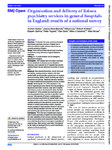Organisation and delivery of liaison psychiatry services in general hospitals in England: results of a national survey
| dc.contributor.author | Walker, A | en |
| dc.contributor.author | Barrett, JR | en |
| dc.contributor.author | Lee, W | en |
| dc.contributor.author | West, RM | en |
| dc.contributor.author | Guthrie, E | en |
| dc.contributor.author | Trigwell, P | en |
| dc.contributor.author | Quirk, A | en |
| dc.contributor.author | Crawford, MJ | en |
| dc.contributor.author | House, A | en |
| dc.date.accessioned | 2021-09-21T12:52:03Z | |
| dc.date.issued | 2018-09-01 | en |
| dc.identifier.issn | 2044-6055 | en |
| dc.identifier.other | ARTN e023091 | en |
| dc.identifier.uri | http://hdl.handle.net/10026.1/17918 | |
| dc.description.abstract |
Objectives To describe the current provision of hospital-based liaison psychiatry services in England, and to determine different models of liaison service that are currently operating in England. Design Cross-sectional observational study comprising an electronic survey followed by targeted telephone interviews. Setting All 179 acute hospitals with an emergency department in England.Participants168 hospitals that had a liaison psychiatry service completed an electronic survey. Telephone interviews were conducted for 57 hospitals that reported specialist liaison services additional to provision for acute care. Measures Data included the location, service structures and staffing, working practices, relations with other mental health service providers, policies such as response times and funding. Model 2-based clustering was used to characterise the services. Telephone interviews identified the range of additional liaison psychiatry services provided. Results Most hospitals (141, 79%) reported a 7-day service responding to acute referrals from the emergency department and wards. However, under half of hospitals had 24 hours access to the service (78, 44%). One-third of hospitals (57, 32%) provided non-acute liaison work including outpatient clinics and links to specialist hospital services. 156 hospitals (87%) had a multidisciplinary service including a psychiatrist and mental health nurses. We derived a four-cluster model of liaison psychiatry using variables resulting from the electronic survey; the salient features of clusters were staffing numbers, especially nursing; provision of rapid response 24 hours 7-day acute services; offering outpatient and other non-acute work, and containing age-specific teams for older adults. Conclusions This is the most comprehensive study to date of liaison psychiatry in England and demonstrates the wide availability of such services nationally. Although all services provide an acute assessment function, there is no uniformity about hours of coverage or expectation of response times. Most services were better characterised by the model we developed than by current classification systems for liaison psychiatry. | |
| dc.language.iso | en | en |
| dc.publisher | BMJ Publishing Group | en |
| dc.subject | consultation-liaison | en |
| dc.subject | health services research | en |
| dc.subject | hospital psychiatry | en |
| dc.subject | liaison psychiatry | en |
| dc.subject | mental health | en |
| dc.title | Organisation and delivery of liaison psychiatry services in general hospitals in England: results of a national survey | en |
| dc.type | Journal Article | |
| plymouth.author-url | http://gateway.webofknowledge.com/gateway/Gateway.cgi?GWVersion=2&SrcApp=PARTNER_APP&SrcAuth=LinksAMR&KeyUT=WOS:000446470200173&DestLinkType=FullRecord&DestApp=ALL_WOS&UsrCustomerID=11bb513d99f797142bcfeffcc58ea008 | en |
| plymouth.issue | 8 | en |
| plymouth.volume | 8 | en |
| plymouth.journal | BMJ Open | en |
| dc.identifier.doi | 10.1136/bmjopen-2018-023091 | en |
| plymouth.organisational-group | /Plymouth | |
| dcterms.dateAccepted | 2018-07-27 | en |
| dc.rights.embargodate | 2021-09-22 | en |
| dc.rights.embargoperiod | Not known | en |
| rioxxterms.versionofrecord | 10.1136/bmjopen-2018-023091 | en |
| rioxxterms.licenseref.uri | http://www.rioxx.net/licenses/all-rights-reserved | en |
| rioxxterms.licenseref.startdate | 2018-09-01 | en |
| rioxxterms.type | Journal Article/Review | en |


